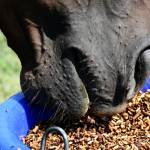Genetically Speaking: Behavior and Nutrition Linked in Horses

As horse owners, we’ve heard it before: horses sometimes experience a “sugar rush” after consuming certain feeds, resulting in high-strung behavior. Fact or folklore? According to a recent study, genetic material may hold the clues as to why this long-held suspicion might be fact.
In studies using other species, researchers have noted a relationship between an imbalance of microorganisms in the gastrointestinal tract, called gut dysbiosis, and neurological alterations, specifically a change in behavioral reactivity related to diet.
To explore this gut-neuro link and to determine reasons for increased reactivity in horses, researchers set out to develop a method to measure the density of neurotransmitter receptors for dopamine and serotonin in brain and intestinal tissues.
“Ponies were fed either a high-fiber or high-starch diet for two weeks. The diets contained the same number of calories. Researchers extracted RNA (ribonucleic acid) from brain and intestinal tissues. RNA is vital in various biological roles, such as coding, decoding, regulation, and expression of genes,” explained Catherine Whitehouse, M.S., a nutrition advisor for Kentucky Equine Research. “The researchers identified and measured several neurotransmitter receptors for both dopamine and serotonin in tissues.”
Results of the study proved promising, allowing “the relative quantification of neurotransmitter densities in brain and gut tissues” and setting the stage for “further investigation into the mechanisms behind dietary induced behavioral changes,” according to the researchers. “These investigations will develop understanding of gut-brain axis communication pathways.” These pathways may play a role in stereotypic behaviors such as cribbing.
Formulating a diet that meets nutritional needs and promotes the health of the gastrointestinal tract is important for all horses. Nourishing high-strung horses can add a layer of complexity to diet formulation, primarily in choosing the best type of concentrate to provide, according to Whitehouse. Start with good-quality forage appropriate for your horse and then augment with a low-starch feed.
“For horses requiring more energy than can be obtained from a forage-only diet, look for feeds that utilize fat and soluble fibers as the main energy sources. Fat sources would include rice bran and vegetable oil, whereas soluble fibers may include beet pulp or soy hulls,” Whitehouse explained.
Click here to learn more about high-quality KER partner feeds and their availability in your area.
*Bulmer, H., J. Murray, N. Burns, et al. 2019. Development of methods to investigate the mechanisms behind increased behavioral reactivity associated with an increased-starch diet. Journal of Equine Veterinary Science. 76:66.








